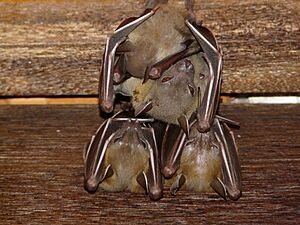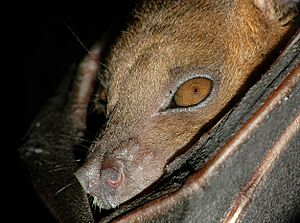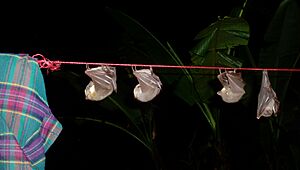Lesser short-nosed fruit bat facts for kids
Quick facts for kids Lesser short-nosed fruit bat |
|
|---|---|
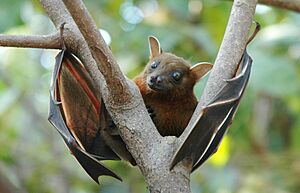 |
|
| C. brachyotis on branch | |
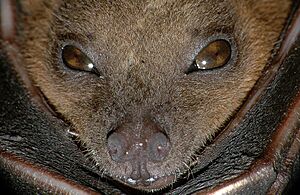 |
|
| Close-up of face | |
| Conservation status | |
| Scientific classification | |
| Genus: |
Cynopterus
|
| Species: |
brachyotis
|
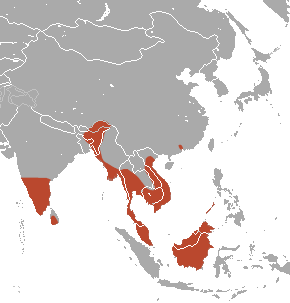 |
|
| Lesser short-nosed fruit bat range | |
The lesser short-nosed fruit bat (Cynopterus brachyotis) is a small bat. It is a type of megabat, which means "large bat". These bats belong to a family called Pteropodidae. You can find them in South Asia and Southeast Asia.
This bat is quite small. It weighs about 21 to 32 grams, which is like a few coins. It measures about 7 to 12.7 centimeters long. These bats live in many different places. They often live in forests, including mountain forests and rainforests. You can also find them in gardens, mangroves, and near beaches.
Contents
What They Look Like
Lesser short-nosed fruit bats are usually brown or yellowish-brown. They have a brighter colored collar around their neck. Adult male bats have dark orange collars. Adult females have yellowish collars. Young bats might have a less clear collar.
The edges of their ears and their wing bones are usually white. These bats have a face that looks a bit like a fox. They also have large, dark eyes. Their head and body are about 7 to 8 centimeters long. Their forearm is about 6 to 7 centimeters long. Their tail is very short, only about 0.8 to 1.0 centimeter. Their ears are about 1.4 to 1.6 centimeters long.
There are nine different types, or subspecies, of the lesser short-nosed fruit bat. These different types have slight differences depending on where they live.
These bats can live for a long time. Their lifespan is usually about 20 to 30 years.
Similar Animals
The greater short-nosed fruit bat looks a lot like the lesser short-nosed fruit bat. However, the greater short-nosed fruit bat has longer forearms and ears. It also has a much longer skull.
Other similar bats have different features. Some might have only one pair of lower teeth. Others might not have white edges on their ears. Some are usually a greyer color.
What They Eat
Lesser short-nosed fruit bats are frugivorous. This means they mostly eat fruit. They especially like fruits that smell strong, like mangoes.
These bats eat small fruits. They usually suck out the juices and soft parts of the fruit. They also enjoy eating nectar and pollen from flowers.
Reproduction and Life Cycle
Lesser short-nosed fruit bats have a mating system called polygynous. This means one male bat mates with several female bats. In some places, like the Philippines, female bats usually give birth twice a year. You can find pregnant females almost any month.
A mother bat is pregnant for about 3.5 to 4 months. After the baby is born, the mother feeds it milk for about six to eight weeks. Male bats become ready to have babies at about one year old. Most female bats can get pregnant when they are about six to eight months old.
In some areas, like Peninsular Malaysia and Thailand, these bats breed all year round. Usually, only one baby is born at a time. The mother carries the young bat when it is very small. More pregnancies happen from March to June. They also have peaks in January and September. The time when mothers feed their babies milk matches the rainy season. It also matches the time when fruits are ripe. Both male and female bats help take care of the young. Male bats even help with feeding the young. They have milk glands that are the same size as the females'.
Behavior
Lesser short-nosed fruit bats like to rest, or roost, in small groups. They often roost in trees, under leaves, or in caves. Young male bats might roost by themselves. It is common for one male bat to roost with up to four female bats. Female bats might gather in larger groups of up to 20.
To find food, these bats bite off the middle part of palm fruit clusters. This leaves a hollow space where they can hang. They also use this method to build shelters. Male bats might spend more than two months chewing on leaves and palm fronds. They do this until the leaves fall to form a shelter.
These bats use touch, sight, and sounds to talk to each other. They find food using their excellent sense of smell. They use their sharp eyesight to find their way around.
Where They Live
The first lesser short-nosed fruit bats studied were found in Borneo in 1836. They were also found near Jammut on the Teweh River in Borneo.
These bats live in many places. You can find them in Sri Lanka, parts of India, Bangladesh, and the Andaman and Nicobar Islands. They also live in southern China, southern Burma, Indochina, Thailand, the Malay Peninsula, Sumatra, Java, Bali, Sulawesi, and the Philippines. They are also on the Lesser Sunda Islands.
The main type of this bat, C. b. brachyotis, lives in Borneo, Lombok, Peninsular Malaysia, the Philippines, and Sulawesi. You can find them from sea level up to about 1,600 meters high. Other types live in specific areas. For example, C. b. altitudinis lives in the highlands of Peninsular Malaysia.
Importance to Nature
Lesser short-nosed fruit bats can fly, so they are safe from many animals that hunt on the ground. Some people eat these bats as a special food.
These bats are very important for plants. They help with pollination, which is how plants make seeds. Plants like bananas, avocados, dates, mangoes, and peaches need these bats. The bats help spread their seeds. Sometimes, people see these bats as pests because they eat and damage fruit crops.
How They Are Protected
The lesser short-nosed fruit bat is listed as a "least-concern species." This means that experts believe their population is stable and there are still many of them. This decision was made by the International Commission on Zoological Nomenclature (ICZN).
However, there are still some possible dangers to these bats. Their homes might be lost because of new buildings, dams, or cutting down forests. Also, some people hunt these animals for medical reasons.



